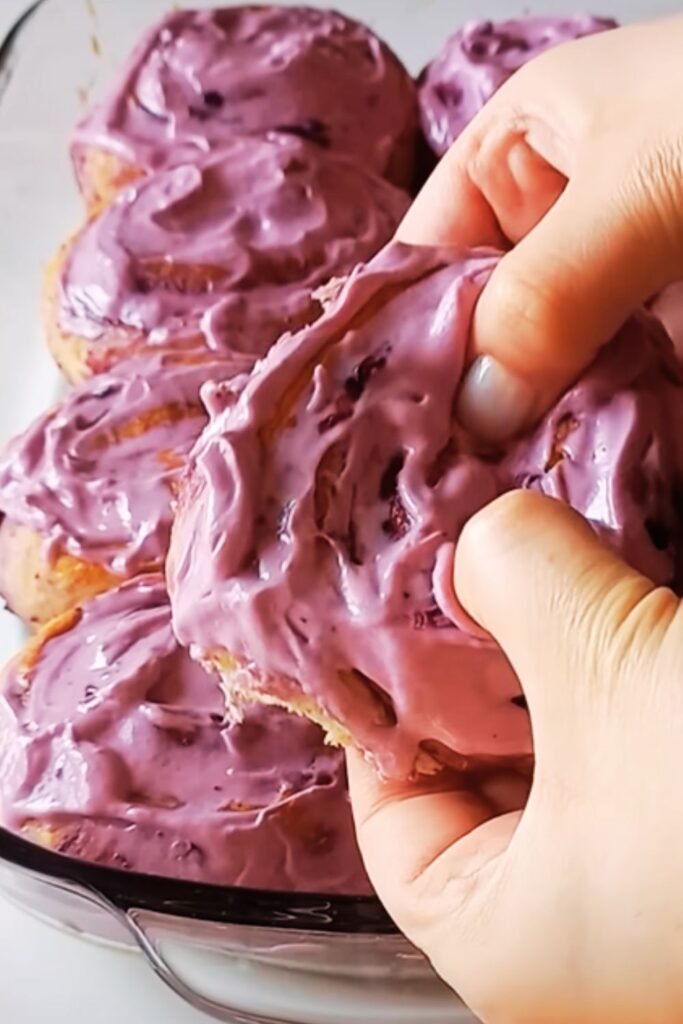There’s something magical about the aroma of freshly baked cinnamon rolls wafting through my kitchen on a weekend morning. When I first decided to elevate this classic comfort food by adding plump, juicy blueberries, I never imagined how transformative that simple addition would be. The burst of tartness from the berries creates a delightful contrast to the warm, sweet cinnamon filling, making these blueberry cinnamon rolls an absolute showstopper.
I’ve spent countless hours perfecting this recipe, testing different techniques and ingredient combinations to achieve that perfect balance of flavors and textures. What I’ve discovered is that making exceptional blueberry cinnamon rolls isn’t just about following a recipe – it’s about understanding the science behind the dough, the importance of timing, and the art of layering flavors.
Understanding the Foundation: Key Components
Enriched Dough : A tender, slightly sweet yeast dough that serves as the canvas for our filling. Unlike regular bread dough, this contains eggs, butter, and sugar for richness and softness.
Cinnamon Sugar Filling : The heart of any cinnamon roll, combining ground cinnamon with brown sugar for depth and molasses notes that complement the fruit.
Fresh Blueberries : The star addition that transforms ordinary cinnamon rolls into something extraordinary. I prefer using fresh berries over frozen for better texture control.
Cream Cheese Glaze : A tangy-sweet topping that adds moisture and balances the sweetness while highlighting the blueberry flavor.
The Science Behind Perfect Blueberry Cinnamon Rolls
Creating exceptional blueberry cinnamon rolls requires understanding how each component interacts. The yeast in our dough not only provides lift but also develops complex flavors through fermentation. When I add blueberries to the filling, I’m careful about moisture content – too much liquid from the berries can make the dough soggy and prevent proper rising.
I’ve learned that coating fresh blueberries lightly in flour before adding them to the filling helps absorb excess moisture while preventing the berries from sinking to the bottom during baking. This technique ensures even distribution throughout each roll.
Essential Ingredients and Their Roles
| Ingredient | Purpose | Quality Tips | Substitution Notes |
|---|---|---|---|
| Bread Flour (3½ cups) | Provides structure and chewiness | Look for 12-14% protein content | All-purpose flour works but reduces chewiness |
| Active Dry Yeast (1 packet) | Leavening agent | Check expiration date; should foam when proofed | Instant yeast can be used in same quantity |
| Whole Milk (1 cup) | Adds richness and tenderness | Use full-fat for best results | 2% milk acceptable, avoid skim |
| Unsalted Butter (6 tbsp) | Flavor and texture | European-style preferred for higher fat content | Margarine works but affects flavor |
| Large Eggs (2) | Structure and richness | Room temperature eggs mix better | Cannot substitute in yeast dough |
| Fresh Blueberries (1½ cups) | Star flavor component | Firm, plump berries with good color | Frozen berries must be thawed and drained |
| Ground Cinnamon (2 tbsp) | Primary spice | Ceylon cinnamon preferred for delicate flavor | Cassia cinnamon is more common but stronger |
| Brown Sugar (¾ cup) | Sweetness and molasses flavor | Light brown sugar for subtle flavor | Dark brown sugar for more intense molasses notes |
| Cream Cheese (8 oz) | Glaze base | Full-fat, room temperature | Greek yogurt can substitute but changes texture |
Step-by-Step Preparation Method
Preparing the Dough
I always start by activating my yeast to ensure it’s alive and ready to work. In a small bowl, I combine warm milk (heated to exactly 110°F – I use a thermometer to be precise) with a pinch of sugar and the yeast. After 5-10 minutes, the mixture should be foamy and fragrant. If it doesn’t foam, the yeast is dead, and I start over with fresh yeast.
In my stand mixer bowl, I combine the flour, remaining sugar, and salt. I create a well in the center and add the activated yeast mixture, beaten eggs, and melted butter. Using the dough hook attachment, I mix on low speed until the ingredients come together, then increase to medium speed and knead for 8-10 minutes until the dough is smooth and elastic.

The dough should be slightly sticky but not wet. I’ve found that the key to perfect texture is resisting the urge to add too much flour during kneading. A properly hydrated dough will feel tacky to the touch but shouldn’t stick to your hands when handled gently.
First Rise and Shaping
After kneading, I place the dough in a greased bowl, cover it with a damp kitchen towel, and let it rise in a warm, draft-free location for about 1 hour, or until doubled in size. I like to use my oven with just the light on – it creates the perfect environment for rising.
Once the dough has doubled, I punch it down gently to release the gases and turn it out onto a lightly floured surface. Using a rolling pin, I roll the dough into a 15×12-inch rectangle, being careful to maintain even thickness throughout.
Creating the Filling
For the filling, I combine the brown sugar and cinnamon in a small bowl. I’ve experimented with adding a pinch of cardamom or nutmeg, which creates lovely complexity, but the classic combination is hard to beat.
I spread the softened butter evenly across the dough surface, leaving a small border along one long edge. Then I sprinkle the cinnamon-sugar mixture over the butter, ensuring even distribution. Finally, I gently press the mixture into the butter and scatter the flour-dusted blueberries across the surface.
Rolling and Cutting Technique
Rolling the dough requires a gentle but firm touch. Starting from the long edge opposite the border I left, I roll the dough tightly but not so tight that the filling squeezes out the sides. I’ve learned that maintaining consistent pressure while rolling creates more uniform rolls.

Using a sharp knife or unflavored dental floss (my preferred method for clean cuts), I slice the log into 12 equal pieces. Dental floss prevents the squashing that can occur with a knife and maintains the circular shape better.
Baking Techniques and Temperature Control
| Baking Stage | Temperature | Duration | Visual Cues | Internal Temperature |
|---|---|---|---|---|
| Second Rise | Room temp (75-80°F) | 30-45 minutes | Nearly doubled, springs back slowly when poked | N/A |
| Initial Bake | 375°F | 25-30 minutes | Golden brown tops, set centers | 190°F internal |
| Final Browning | 350°F | 5-10 minutes | Deep golden color | 200°F internal |
| Cooling | Room temp | 10 minutes | Firm to touch | Continues to cook from residual heat |
I place the cut rolls in a greased 9×13-inch baking dish, spacing them so they’re just touching. This allows them to support each other during the second rise while still maintaining individual shape. Cover with a clean kitchen towel and let rise for another 30-45 minutes.
The second rise is crucial for achieving that pillowy texture. I know they’re ready when the rolls have nearly doubled again and spring back slowly when gently poked with my finger.
Mastering the Glaze
The cream cheese glaze is what transforms good blueberry cinnamon rolls into extraordinary ones. I bring the cream cheese to room temperature completely – this usually takes about 2 hours on my counter. Cold cream cheese will create lumps no matter how much I beat it.
In a medium bowl, I beat the cream cheese until smooth and fluffy, about 2 minutes with an electric mixer. Gradually, I add powdered sugar, vanilla extract, and a small amount of milk or heavy cream until I achieve the desired consistency. The glaze should coat the back of a spoon but still flow easily.
For blueberry cinnamon rolls, I sometimes add a tablespoon of fresh lemon juice to the glaze, which brightens the flavors and complements the fruit beautifully.
Troubleshooting Common Issues
Dense, Heavy Rolls : Usually caused by over-flouring the dough or insufficient rising time. I ensure my measuring is accurate and allow full rising time even if it takes longer than expected.
Filling Leakage : This happens when the dough is rolled too tightly or the filling is too wet. I’ve learned to roll firmly but not aggressively, and I always drain any excess moisture from the blueberries.
Uneven Baking : Often results from inconsistent roll sizes or oven hot spots. I rotate my pan halfway through baking and ensure my cuts are as uniform as possible.
Dry Texture : Can occur from overbaking or insufficient fat in the dough. I watch carefully during the final minutes of baking and always check internal temperature.
Storage and Reheating Guidelines

Proper storage maintains the texture and flavor I work so hard to achieve. For short-term storage (up to 3 days), I cover the rolls tightly with plastic wrap and store at room temperature. The cream cheese glaze requires refrigeration if the rolls will be stored longer than 24 hours.
For longer storage, I wrap individual rolls in plastic wrap and freeze for up to 3 months. To reheat, I thaw overnight in the refrigerator, then warm in a 350°F oven for 5-7 minutes. This method preserves the tender texture better than microwave reheating.
Nutritional Considerations and Modifications
| Modification | Impact on Texture | Impact on Flavor | Success Rate |
|---|---|---|---|
| Whole Wheat Flour (50% substitution) | Slightly denser | Nuttier, more complex | High |
| Reduced Sugar (25% less) | Minimal change | Less sweet, fruit flavor more prominent | High |
| Greek Yogurt for Butter | Slightly less tender | Tangier, less rich | Medium |
| Egg Substitute | Minor texture change | Minimal impact | Medium |
| Gluten-Free Flour Blend | Significantly different | Similar if using good blend | Low |
Seasonal Variations and Flavor Combinations
While blueberries are the star of this recipe, I’ve experimented with seasonal variations that maintain the same technique but offer different flavor profiles:
Summer Variations: Fresh raspberries or blackberries work beautifully, though they’re more delicate and require gentler handling. Peach and cinnamon create a wonderful combination, though I dice the peaches small and remove excess moisture.
Fall Adaptations: Adding finely diced apple with extra cinnamon creates an apple pie-inspired version. I sometimes include a pinch of cardamom or allspice for warmth.
Winter Comfort: Dried cranberries soaked in warm orange juice provide tartness and prevent the rolls from becoming too sweet.
Advanced Techniques for Extra Special Results
After years of making these rolls, I’ve developed several advanced techniques that elevate the final product:
Overnight Development: I sometimes prepare the rolls through the shaping stage, then refrigerate overnight. This slow fermentation develops more complex flavors, though I need to allow extra time for the final rise as the cold dough takes longer to warm up.
Steam Injection: Placing a small oven-safe dish of hot water on the oven floor during the first 10 minutes of baking creates steam that helps achieve a softer crust.
Brown Butter Enhancement: Browning the butter before adding it to the filling creates nutty, complex flavors that complement the blueberries beautifully.
Serving Suggestions and Presentation
These blueberry cinnamon rolls shine as the centerpiece of a special breakfast or brunch. I like to serve them warm, about 10 minutes after removing from the oven – this timing allows the glaze to set slightly while maintaining the rolls’ tender interior.
For special occasions, I dust the glazed rolls with a light sprinkle of cinnamon or arrange fresh blueberries around the serving platter. A pot of high-quality coffee or tea complements the sweet-tart flavors perfectly.
When serving for a crowd, I keep the rolls warm in a low oven (200°F) for up to an hour. Individual serving plates allow guests to appreciate the beautiful spiral pattern and enjoy every morsel of the cream cheese glaze.
Questions and Answers
Q: Can I make the dough ahead of time and refrigerate it overnight?
Yes, and this actually improves the flavor! After the first rise, punch down the dough, cover tightly, and refrigerate for up to 24 hours. The cold fermentation develops more complex flavors. Just remember to bring it to room temperature before rolling out, which takes about 30 minutes.
Q: Why do my blueberries always sink to the bottom of the rolls?
This happens when the berries are too wet or heavy for the dough structure. I solve this by patting fresh berries dry with paper towels and tossing them in a tablespoon of flour before adding to the filling. This coating helps them stay suspended in the dough during baking.
Q: Can I use frozen blueberries instead of fresh ones?
You can, but the technique changes slightly. Thaw the berries completely and drain any excess liquid. Pat them very dry with paper towels and toss with flour before using. Frozen berries release more moisture, so I sometimes reduce other liquids in the recipe by 1-2 tablespoons.
Q: How do I know when my cinnamon rolls are perfectly baked?
I use both visual and temperature cues. The tops should be golden brown and spring back lightly when touched. More importantly, the internal temperature should reach 190-200°F when measured with an instant-read thermometer inserted into the center of a middle roll.
Q: Can I make these rolls dairy-free?
Yes, with some modifications. Replace the milk with unsweetened plant milk (oat or soy work best), use vegan butter for both the dough and filling, and create a glaze using vegan cream cheese or powdered sugar mixed with plant milk and vanilla.
Q: Why did my rolls turn out dense instead of fluffy?
Dense rolls usually result from inactive yeast, too much flour, or insufficient rising time. Always proof your yeast first to ensure it’s active, measure flour by weight if possible (or spoon and level if using cups), and don’t rush the rising process even if it takes longer than expected.
Q: How can I prevent the filling from leaking out during baking?
Leave a small border without filling along one edge when spreading your mixture, roll firmly but not too tightly, and make sure your dough isn’t too thin. Also, ensure your baking dish is the right size – rolls that are too crowded or too spread out can cause uneven baking and leakage.
Q: What’s the best way to reheat leftover cinnamon rolls?
For best results, wrap individual rolls in slightly damp paper towels and microwave for 20-30 seconds, or reheat in a 350°F oven for 5-7 minutes. If they seem dry, brush lightly with milk before reheating. Avoid overheating, which makes them tough.
The journey to perfect blueberry cinnamon rolls has taught me that baking is both science and art. Each batch teaches me something new about dough behavior, flavor balance, or technique refinement. What started as a simple desire to improve upon classic cinnamon rolls has become a deeply satisfying process that brings joy to my kitchen and happiness to everyone who tastes the results.
These rolls represent more than just a breakfast treat – they’re an expression of care, patience, and the simple pleasure of creating something beautiful and delicious from basic ingredients. Whether you’re making them for a special occasion or just because your kitchen deserves to smell amazing, I hope this guide helps you create your own perfect batch of blueberry cinnamon rolls.